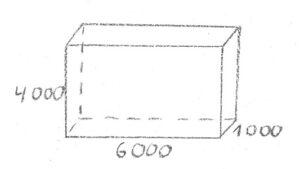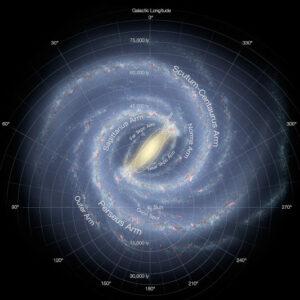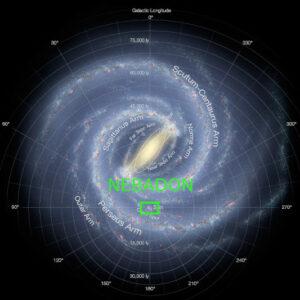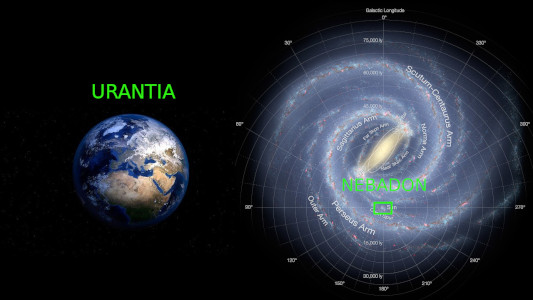Hello everyone! My name is Sławomir Żydenko and I come from Poland. Welcome on the internet service dedicated to the Urantia Book.
My dear readers, in the last article there were many mysteries left unsolved, and the purpose of my work is to make the Urantia Book easier to understand. Therefore, I believe that the following definitions of space objects and structures are worth explaining and, if possible, associating with the names currently in use. The present post should therefore be regarded as a continuation of the previous one, and I therefore encourage everyone to read it as well. Link to the previous post I put in the description. The posts are written by me in Polish and then translated into English, German and Russian. If I make a mistake or misunderstand something, please be understanding and feel free to comment on it.
I start with a fragment from the Preface, which contains a large accumulation of astronomical terms. Please read:
”0:0.5 (1.5) Your world, Urantia, is one of many similar inhabited planets which comprise the local universe of Nebadon. This universe, together with similar creations, makes up the superuniverse of Orvonton, from whose capital, Uversa, our commission hails. Orvonton is one of the seven evolutionary superuniverses of time and space which circle the never-beginning, never-ending creation of divine perfection—the central universe of Havona. At the heart of this eternal and central universe is the stationary Isle of Paradise, the geographic center of infinity and the dwelling place of the eternal God.
0:0.6 (1.6) The seven evolving superuniverses in association with the central and divine universe, we commonly refer to as the grand universe; these are the now organized and inhabited creations. They are all a part of the master universe, which also embraces the uninhabited but mobilizing universes of outer space.” The quote is from the website:
https://www.urantia.org/urantia-book-standardized/foreword
The descriptions of cosmic objects and structures in the text do not allow us to assign them present names. As I said in the previous post, we are reading the introduction to The Urantia Book for now, so all the described objects are explained more extensively in later parts of the Book. I took the trouble for you and searched on a search engine. I searched for results that would allow naming the given objects and structures with today’s names. A lot of ambiguity is resolved in Paper number 15, but I don’t want to go through long passages from Paper number 15 because there will be time for that later. Let me quote some of the most relevant passages from Paper number 15 or from other parts of the book and my interpretation for each term not explained in the previous post.
The guiding thought for me is to read the Book and understand it – right from the beginning.
To begin, let’s deal with the first sentence:
„0:0.5 (1.5) Your world, Urantia, is one of many similar inhabited planets which comprise the local universe of Nebadon.”
URANTIA
And we have the first unknown word, namely Urantia. It is clear from the very first line of the Preface that the word Urantia means “Earth” in the language of the beings editing the Book, and I quote:
“0:0.1 (1.1) IN THE MINDS of the mortals of Urantia—that being the name of your world—there exists great confusion respecting the meaning of such terms as God, divinity, and deity.”
According to the quote, Urantia is Earth and there is no doubt about it.
NEBADON
Another unknown term is the local universe of Nebadon – according to the quote from the Preface, it is a component of the superuniverse of Orvonton. This doesn’t explain much, and what do the later parts of the Book say about it?
To begin with, I will quote from the Urantia Book from Paper 32:
“32:2.4 (359.1) Salvington, the headquarters of Nebadon, is situated at the exact energy-mass center of the local universe. But your local universe is not a single astronomic system, though a large system does exist at its physical center.”
https://www.urantia.org/urantia-book-standardized/paper-32-evolution-local-universes
There is a rather pessimistic information here, namely that Nebadon is not a separate astronomical unit. Therefore, it will be rather difficult to call it by its current name.
But let’s not be so pessimistic, maybe we can explain at least a little what Nebadon is.
Size
To give some idea of the size of Nebadon, I will quote one sentence from Paper 15:
“15:2.5 (166.4) 3. The Local Universe. One hundred constellations (about 10,000,000 inhabitable planets) constitute a local universe.”
https://www.urantia.org/urantia-book-standardized/paper-15-seven-superuniverses
About habitable planets, of course, we have no data. So far, scientists are able to discover planets and generally state their chemical composition, at least as far as the surface is concerned. An important detail and curiosity is that The Urantia Book was published in 1955, while the first full confirmation of a previously discovered planet outside the solar system was made in 1992. The discovery of planets is happening now at a fairly rapid pace. So far, about five thousand exoplanets, that is planets outside the solar system, have been discovered.
https://en.wikipedia.org/wiki/Exoplanet
Information about the number of habitable planets is unmeasurable, so it does not give us much. To get an idea of the size of the space in question, we need to “convert” planets into observable suns.
To do this, we will use two quotes from Paper 15. I quote:
“15:2.8 (166.7) 6. The Superuniverse. Ten major sectors (about 1,000,000,000,000 inhabitable planets) constitute a superuniverse.”
And following quote:
“15:6.10 (172.12) The superuniverse of Orvonton is illuminated and warmed by more than ten trillion blazing suns. These suns are the stars of your observable astronomic system.”
https://www.urantia.org/urantia-book-standardized/paper-15-seven-superuniverses
These quotations are very important. Assuming that what we are reading is true and that there were no mistakes during the transcription and preparation of the Book for printing, we obtain a significant conversion of the data used in the Book. The editors of the Book, as spiritual beings, speak of data that is essential to them, that is, habitable planets, that is, inhabited or liveable. After all, it is on the planets that life takes place, and the suns only produce energy for that life. We, humans, as material beings, can only talk about objects that can be observed by us, that is, about shining stars. It is known that inhabited or habitable planets need energy from the suns, so they can only exist near them.
And here we have a point of contact. From the above quotes, we learn that Orvonton has over ten trillion blazing suns, and a moment earlier we learned that superuniverses have on average a trillion habitable planets. So the ratio is 10 to 1 – for every ten suns there is one habitable, that is, inhabited or habitable planet.
Let us now return to explaining the size of Nebadon. As a reminder, I will read again the quote from Paper number 15:
“15:2.5 (166.4) 3. The Local Universe. One hundred constellations (about 10,000,000 inhabitable planets) constitute a local universe.”
https://www.urantia.org/urantia-book-standardized/paper-15-seven-superuniverses
In the above quote, we learn that Nebadon consists of ten million habitable planets. Multiplying this, times the conversion we just obtained, we get a hundred million “blazing suns”.
How can you imagine such a space? I will use Wikipedia for this purpose. There we can find a statistical sample for further calculations. On the page about the nearest stars to the Earth, we will get another converter.
Within the radius of 16.31 light years from the Earth, including the Sun, there are 76 stars. For those who are not familiar with it, I would like to explain that a light year is a measure of distance and defines the distance that light travels in one year. Light travels about three hundred thousand kilometers per second. Just multiply this number by the number of seconds in a year, and you get about nine and a half trillion kilometers.
https://en.wikipedia.org/wiki/List_of_nearest_stars_and_brown_dwarfs
We can calculate the approximate size of Nebadon from this data. To use the acquired sample, we need the formula for the volume of the sphere. We make the calculation in light years, of course. Just as wood on a pile is calculated in cubic meters, we will calculate Nebadon in cubic light years. I will show this below:
V=4/3*π*r3
V=4/3*3.14*16.31 light years*16.31 light years*16.31 light years
V=18,164.78 light years3
In the first line we have the formula for the volume of the sphere. In the second line, I inserted the numerical data into the formula. And finally we have the result, of course, in cubic light years – 76 stars occupy a space of eighteen thousand one hundred and sixty-four and seventy-eight-tenths cubic light years.
Let us now divide the space occupied by the stars by their number:
18,164.78 light years3 / 76 stars = 239.01 light years3 / star
~ 240 light years3 / star
So there are about two hundred and forty cubic light years per star when rounded to whole tens.
A moment earlier, we determined that Nebadon is composed of one hundred million stars. We must now calculate how much space they would occupy. We multiply the number of stars times the conversion factor of the space occupied by one star:
100 000 000 stars * 240 light years3 / star = 24 000 000 000 light years3
The result of the calculation is twenty-four billion cubic light years.
For a better idea, let us build a cuboid of this volume. The individual sides of my cuboid have the dimensions as in Figure below:

6 000 light years * 4 000 light years * 1000 light years = 24 000 000 000 light years3
We obtain a cuboid six thousand light years long, four thousand light years wide, and one thousand light years high. The height of the cuboid equals the approximate thickness of the galactic disk.
Now take a look at our Galaxy from the Wikipedia page:

https://en.wikipedia.org/wiki/Milky_Way
And now at the same graphic with Nebadon imprinted on it.

This cuboid is a visualization of Nebadon. The size of the cuboid is proportional to the size of the Milky Way.
This cuboid is, of course, purely my idea to visualize my calculations. In no way, I do claim that Nebadon looks exactly like this. The entire Galaxy is one hundred thousand in diameter and one thousand light years thick. One Nebadon would occupy a large part of the Galaxy. My point is that from the quoted sentences it follows that in the superuniverse of Orvonton there are as many as a hundred thousand local universes, such as Nebadon. However, it is important to remember that the greatest density of matter is at the center of the disk. Local universes are defined in fixed numbers, so they would be much, much smaller in the center than in the outer part of the disk. Given the size of the entire Galaxy, however, the result is quite possible, isn’t it? What you think about this?
In conclusion, it is impossible to name Nebadon by its modern astronomical name. At least I can’t. According to the Urantia Book, it is a more administrative unit than an astronomical one. From the calculations, it is quite a large part of space.
I hope my efforts accomplished something and helped at least a little in imagining the size of the local universe of Nebadon.
My dear readers, at this point I will end this post. I have material prepared for the next article for next week. I intend to write and publish regularly once a week, even if it has to be short texts. Next week we’ll consider about the Orvonton and Uversa.
In the meantime, I say goodbye to you. Please write in the comments what you think about this.
Until next time, best regards!
Link to the first part:
https://urantia.online/en/god-the-universe-and-other-planets-the-urantia-book-foreword_1/
Link to video:
Facebook:
https://www.facebook.com/slawomir.zydenko/
Quotes sources:
https://www.urantia.org/urantia-book-standardized/foreword
https://www.urantia.org/urantia-book-standardized/paper-32-evolution-local-universes
https://www.urantia.org/urantia-book-standardized/paper-15-seven-superuniverses
https://en.wikipedia.org/wiki/Exoplanet
https://en.wikipedia.org/wiki/List_of_nearest_stars_and_brown_dwarfs
https://en.wikipedia.org/wiki/Milky_Way
Source of thumbnail graphics:
https://pixabay.com/pl/illustrations/ziemia-planeta-%c5%9bwiat-glob-1617121/
https://en.wikipedia.org/wiki/Milky_Way

